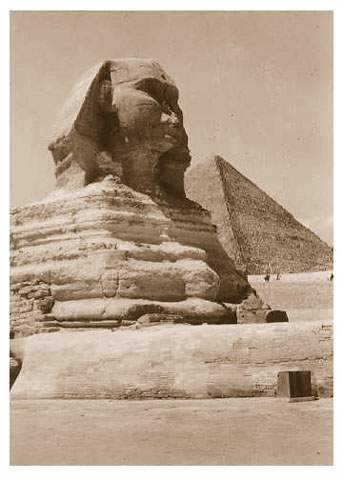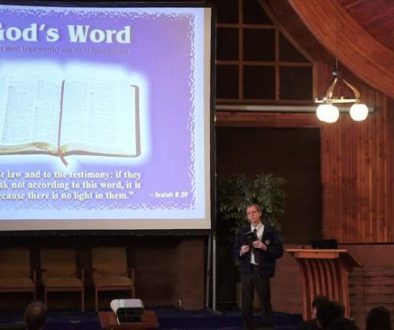The Sphinx
The Sphinx, unlike the Pyramids, is carved out of the living rock. It is 241 feet (73.5 meters) long and in parts is 65 feet (20 meters) high. It faces due east,towards the equinox. It has been suggested that it was built around the same time as the construction of the Pyramid of Khafre [Chephren; c.2555-2532 B.C.E.] (the pyramid to the left of the sphinx), but recent findings by John Anthony West suggest that there are water erosions unlike any other marks found on other Giza monuments.Unlike sand and wind erosions, which produce horizontal marks, West found that the erosion marks on the Sphinx were vertical…like those associated by water,but unlike the sand and wind marks which can be explained thanks to the destructive forces of the Sahara,where did the water marks originate?

Well we know that Egyptologist’s believed that the Sphinx was built in 2500 BC in the time of the pharaoh Chephren (of Khafre), so why are there no inscriptions that identify Khafre with the Sphinx? Surely a great monument having to be painstakingly carved out of solid rock would have been celebrated but there is not even the slightest of mention regarding it’s construction.
Dr. Robert Schoch, an geologist and professor from Boston University decided he would examine the new findings and come up with his own answers. He agreed with West’s conclusion regarding the water erosion,and remarked that it was due to the torrential rains pouring down on Egypt’s monuments at that time,so why are there no other water erosions found in Egypt to validate his theory? Surely there wasn’t just a cloud raining down on the Sphinx?
Again Egyptologist’s dismissed Schoch’s theory, saying that the great rain storms that once happened over Egypt had stopped long before the Sphinx was built.Then in stepped Robert Buvaul with his own theory behind the Sphinx’s true age,i will let him in his own words explain his theory:-
In 1989 I published a paper in the Oxford Journal, Discussions In Egyptology (vol. 13), in which I demonstrated that the three Great Pyramids and their relative position to the Nile created on the ground a sort of 3-D ‘hologram’ of the three stars of Orion’s belt and their relative position to the Milky Way. To support this contention, I brought into evidence the inclined shaft in the Great Pyramid which were aimed at the south meridian towards these group of stars as well as written evidence from the Pyramid Texts that identified the afterlife destiny of the pyramid-kings with Orion.
Later in my book The Orion Mystery (Heinemann-Mandarin) I also demonstrated that the best fit for the Giza Pyramids/Nile pattern with the Orion’s belt/Milky Way pattern occurred when the sky was pushed back in time (i.e. precessed) to the epoch of 10,500 BC. There were good reasons for doing so.
The ancient Egyptians, for example, constantly refer to a remote golden age they called Zep Tepi, ‘The First Time’ of Osiris, which they believed had long predated the Pyramid Age. Osiris was Orion, and the Great Pyramid had a shaft directed to Orion at the meridian. To me, this ‘silent’ astro-architectural language seemed to be spelling out ‘here is Osiris in the sky when these pyramids were built, yet know, too, that his origins are rooted in the First Time.’ But The ‘First Time’ of what? How could the stars of Orion have a ‘First Time’?
Well they can. And they do. Provided, of course, that you can read through the allegorical ‘language’ of the ancients via the symbolic architecture and the related Pyramid Texts. Allegory, to put it in another way, is the ‘Q-Basics’ of the master astronomers who designed the Giza complex. When the stars of Orion are observed at the meridian in the precise manner that the ancient Egyptian astronomers did over many centuries, the could not help noting that these stars crossed the south meridian at different altitudes at different epoch. This is, of course, due to the phenomenon of Precession (see The Orion Mystery, appendices 1 and 2). In short, the stars of Orion can be said to have a starting point or ‘beginning’ at the nadir of their precessional cycle. Simple calculations show that this occurred in 10,500 BC. Could the ancient astronomers of the Pyramid Age have used their very clever ‘silent language’ combined with Precession to freeze the ‘First Time’ of Osiris – somewhat like the gifted architects of gothic cathedral froze in its allegorical stonework the ‘time of Christ’?
In the summer of 1993 Graham Hancock and I got together to investigate this issue further. Graham was quick to realised the important implications this approach could have on the Sphinx problem. He had a hunch that the curious harking back to the epoch of 10,500 BC by the pyramid builders of Giza was an invitation by them to consider the actual age of the Sphinx. If this hypothesis was correct, then the Sphinx must be an ‘original’ time-marker of that remote epoch using an obvious celestial tag valid for 10,500 BC. But which tag? What could the Sphinx be representing that was in the sky? Could this have something to do with the due east direction of its gaze towards the horizon?
In his ground-breaking book Fingerprints of the Gods (Heinemann-Mandarin), Hancock pointed out that the ‘First Time’ date of 10,500 BC also denoted the beginning or ‘First Time’ of the Age of Leo. This was when the ‘lion’ constellation would have risen heliacally (at dawn before the sun) on the day of the spring (vernal) equinox. This event brought the celestial lion to rest due east, thus in perfect alignment with the Sphinx. The Sphinx, in other words, was made to look at his own image in the horizon – and consequently at his own ‘time’. Hancock pointed out that 10,500 BC was no random date. It very precisely denoted another beginning, that of Orion-Osiris defined on the ground with the pattern and alignments of the nearby Pyramids. Here, then, were not just the Pyramids but also the Sphinx luring us to the same date of 10,500 BC. But were we dealing with a ‘coincidence’ -albeit an astonishing one- or was all this part of a deliberate long term scheme set by the ancients? Could it be possible that some blueprint was put into motion in 10,500 BC with the making of the Sphinx then to be completed much later by the builders of the Pyramids? Was there evidence of a continuous presence here at Giza through the ages of some master ‘astronomers’ who could have been responsible to see this scheme through?
If so, who were they? Where had they come from? Why here at Giza? Graham and I have spent the last two years researching this fascinating issue. We believe that what we have uncovered will change the perceptions of what Giza was (and still is) forever. The full results of our investigation, as you might have guessed, are laid out in our new book, Keeper of Genesis, available now at a discount through AA&ES. Suffice at this stage to say that author Colin Wilson, who gave the book an early review, thinks it’s ‘a much more satisfying tour de force’ than Fingerprints of the Gods or The Orion Mystery.
So has Robert Buvaul got a ‘good case’ ? Many people seem to validate his theory but maybe we will never truly understand the reasons behind these great monuments, we can only listen to the theory’s behind the mystery and come to our own conclusions, until we are given unquestionable proof their will always be people wanting to knock others idea’s, but please keep an open mind to all possibilities and try to enjoy the experience.
https://www.geocities.com/Athens/Delphi/3499/sphinx.htm






